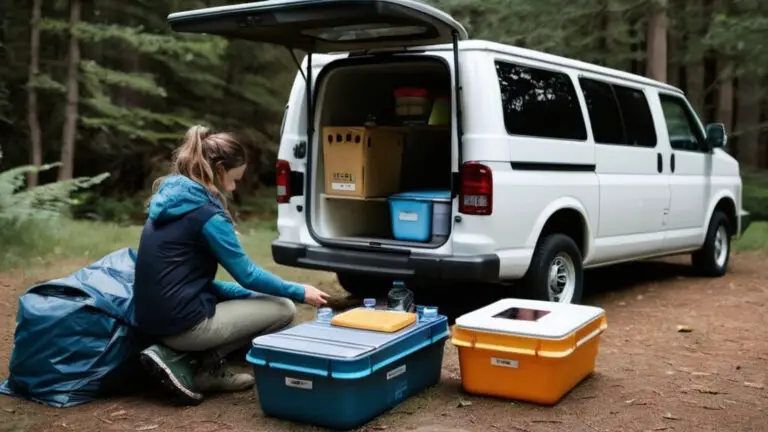Introduction
Downsizing for van life means stripping away the excess and keeping only what supports mobility, functionality, and daily utility. Instead of filling space, the goal becomes maximizing use. A capsule wardrobe replaces a full closet, and a collapsible sink serves the job of a full bathroom. Every object must earn its place—whether it’s a multi-purpose tool, a solar charger, or a foldable bed. A compact van replaces a fixed home, offering freedom but demanding intention. People often bring emotional weight into the process—sentimental value competes with practical need. Here, simplicity becomes strategy, and organization becomes survival. Minimalism shifts from concept to necessity, and storage evolves from convenience to core function.
Key Takeaways
- Downsizing for van life starts with identifying essentials and eliminating non-functional items.
- Emotional attachment can be managed through phased decisions and small-step progress.
- Core principles include function, adaptability, simplicity, and mobility.
- Use structured methods like Swedish death cleaning, KonMari, and ABC prioritization.
- Optimize van space using vertical storage, multipurpose tools, and layout zoning.
- Prepare for the transition with a staged timeline and sustainable offloading plans.
- Regularly rotate gear based on season and maintain monthly decluttering habits.
- Common mistakes include overpacking, ignoring weather needs, and underestimating legal requirements.
Assessing Your Current Possessions
Understanding What You Own
The first step in downsizing for van life is taking inventory of every item you own. Begin with a room-by-room checklist that includes clothing, electronics, kitchen supplies, tools, and toiletries. Duplicates surface quickly—you may find five frying pans or three chargers, all unnecessary in a van setup. Use this moment to define what you use daily versus what simply takes up space.
A simple table can help:
| Category | Keep | Donate | Sell | Trash |
| Jackets | ✓ | ✓ | ||
| Extra cords | ✓ | ✓ | ||
| Cookware | ✓ | ✓ | ||
| Books | ✓ | ✓ |
Apply a 90/90 rule—if you haven’t used it in 90 days and won’t need it in the next 90, it doesn’t belong in the van. Think in terms of utility space, not storage capacity. Only items with daily, multi-use value make the cut.
Sentimental Attachment and Emotional Barriers
Sentimental attachment complicates decluttering. Childhood keepsakes, family gifts, and memorabilia resist logic. But emotional weight has physical consequences in a small van. Instead of discarding immediately, create a “sentimental review box”. Place uncertain items inside and revisit after two weeks. If they weren’t missed, they’re likely unnecessary.
Strategies include:
- Digitize photographs and letters
- Gift heirlooms to family members
- Limit keepsakes to one small container
Decision fatigue is real, especially when every object ties to memory. Use the KonMari principle sparingly: keep only what actively supports joy or usefulness. In van life, space defines value—not nostalgia.
Principles of Minimalist Living for Van Life
Core Values
Minimalism in the context of van life centers on four principles: utility, flexibility, simplicity, and mobility. These values guide what stays and what goes. An object’s importance increases with each function it serves. A foldable bed that converts into a bench holds more value than a static mattress. A power bank that doubles as a lantern offers two solutions in one item.
Instead of focusing on ownership, focus on purpose. Each item you carry should directly support eating, sleeping, driving, working, or staying healthy. Space becomes finite and functional, not decorative.
Common minimalist values include:
- Function over form
- Adaptability over permanence
- Quality over quantity
- Routine over clutter
- Intentional choices over impulse buys
Applying Minimalist Rules
Several methods can help reduce possessions based on practical reasoning:
- Swedish Death Cleaning encourages planning with the end in mind—only keeping what won’t burden others later.
- The KonMari Method asks whether items spark usefulness or happiness.
- ABC Prioritization categorizes items into:
- A – Always used
- B – Backup or sometimes needed
- C – Cut or replace
Another useful strategy is the “one-in, one-out” rule: every new item added to the van must replace something. Redundancy increases stress and weight impacts mobility, so tracking each item’s role is essential.
Downsizing here is less about letting go and more about making deliberate, reversible decisions that support the kind of nomadic lifestyle you’re creating.
Categorizing Essentials for Life on the Road
Daily Essentials
Van life requires a distilled version of everyday items. A capsule wardrobe consisting of interchangeable layers simplifies clothing choices. Stick to moisture-wicking fabrics, like merino wool, and weather-flexible options, like a packable rain shell or thermal base layers. Avoid bulk—two pairs of shoes, one for hiking and one for relaxing, are often enough.
In the kitchen, focus on space-efficient cookware: nesting pots, a compact propane stove, and a collapsible sink are ideal. One cast iron skillet can replace several pans due to its durability and versatility. Reusable containers store dry goods and leftovers, reducing waste and need for refrigeration.
Daily must-haves typically include:
- Multi-tool
- Compact towel
- Headlamp
- Water jug
- First-aid kit
- Dry shampoo
- Reusable bottle
Digital and Technical Tools
Life on the road relies heavily on well-planned technology. A solar charger or power inverter ensures access to devices without draining van batteries. Those who work remotely often install a Wi-Fi router, use a cell signal booster, and carry a power bank with high capacity.
For productivity, a foldable desk, Bluetooth keyboard, and noise-canceling headphones support remote tasks without consuming much space. When signal is weak or unavailable, offline maps, downloaded route planners, and external storage backups keep operations smooth.
Must-have digital tools:
- Hotspot device
- Tablet with offline maps
- GPS unit
- Charging cables
- Action camera
- Dash cam
Every electronic item should be reviewed for its necessity, storage impact, and power draw.
Space Optimization in a Van
Storage Strategies
Maximizing space inside a van means designing around volume, accessibility, and movement. Start with vertical storage: wall-mounted baskets, ceiling nets, and over-door organizers reduce clutter on the floor. Under-bed space can hold slide-out bins, modular drawers, or vacuum-sealed bags for off-season gear. A swivel seat can serve as both workspace and lounge spot, and a foldable table can tuck away between uses.
Common storage tools include:
- Magnetic strips (for tools and utensils)
- Crate systems (labelled by function)
- Velcro pouches (on walls or seat backs)
- Cargo nets (for soft items like clothes or towels)
- Bungee cords (to secure gear in motion)
Keep high-frequency items within reach, and rare-use tools hidden but labeled. Redundant storage kills usability—everything must have one clear home.
Van Layout Considerations
When planning your layout, break the space into zones:
| Zone | Primary Function | Suggested Items |
| Cooking Area | Meal prep | Stove, sink, utensils, dry storage |
| Sleeping Area | Rest and relaxation | Foldable bed, blackout curtains |
| Utility Area | Storage & hygiene | Bins, toilet, shower bag |
| Workstation | Productivity | Foldable desk, charging station |
Accessibility is key. If it takes five steps to get to your socks, you’ll eventually avoid using drawers altogether. Plan for movement inside the van—allow walking space, seated workspace, and safe exits. Avoid top-heavy setups, which can cause imbalance or injury during driving.
Space optimization in van life isn’t about fitting more—it’s about needing less and making the most of it.
Transitioning from Home to Van
Downsizing Timeline
A smooth shift into van life depends on a clear plan. Without structure, the process of sorting, selling, and packing can feel overwhelming. A three-phase model offers a practical path:
- Phase 1: 3 Months Out
Begin room-by-room sorting. Use the four-box method: Keep, Donate, Sell, Trash. Start selling large items like couches and appliances. Back up all digital files. - Phase 2: 1 Month Out
Move remaining essentials into storage crates or labelled bins. Pack trial bags for a test weekend. Digitize paper records and start canceling subscriptions. - Phase 3: 1 Week Out
Final purge. Clear out what you haven’t used. Clean, label, and secure all compartments. Prepare essential bags with daily-use items.
Disposal and Distribution
How you offload unused items matters. Aim to reduce landfill waste through resale, donation, and reuse.
Options include:
- Online resale apps (OfferUp, Facebook Marketplace)
- Thrift store donations
- Specialty recycling (e-waste, batteries, textiles)
- Gifting to family or friends
Sort your goods based on utility and condition. Don’t delay hard choices—postponement leads to pile-ups, especially with “maybe” items. Use a strict decision rubric: if it doesn’t serve you in the van or carry functional/emotional weight, it must go.
Sustainable downsizing supports not only your future in the van—it respects the resources of others and the planet.
Psychological Adjustments and Lifestyle Shifts
Embracing the Mobile Mindset
Living in a van means adjusting your perspective on comfort, space, and routine. The transition brings freedom, but also demands resilience. A fixed address becomes a flexible location, and routines revolve around daylight, weather, and limited resources. What once felt essential—like a spacious closet or full kitchen—now becomes a luxury outside your lifestyle design.
Mental shifts include:
- Accepting impermanence in daily structure
- Redefining comfort in terms of mobility and self-reliance
- Finding security in flexibility, not permanence
Freedom of movement requires the ability to adapt quickly. Whether it’s switching campsites due to weather or using a gas station restroom instead of a home bathroom, flexibility becomes habit.
Staying Mentally Organized
A tidy van helps maintain a tidy mind. Disorganization creates stress in confined spaces. Keep routines for cleaning, sorting, and resetting your space. Use tools like:
- Daily reset checklists
- Zoned storage audits
- Weekly digital backups
- Routine journaling or voice notes
Balance solitude with community interaction. Join van life forums, attend outdoor meetups, or check in with digital groups. Shared experiences reduce feelings of isolation and support emotional flexibility.
Even minimal living requires mental discipline. Your lifestyle will thrive if your habits support structure and your mind stays open to the unexpected.
Common Mistakes and How to Avoid Them
Overpacking Tech and Clothes
One of the most frequent missteps in downsizing for van life is packing based on “what if” instead of “what is.” Many bring full wardrobes and duplicate electronics. In practice, only a core capsule wardrobe and essential tech gear are used.
Avoid:
- Multiple HDMI cables or unused gadgets
- Duplicate tools or cooking appliances
- Clothing “just in case” that never leaves the bin
Solution: Limit yourself to a week’s worth of clothing, one set of tech for work or entertainment, and one multi-use tool for each category.
Ignoring Climate-Specific Needs
Packing the wrong gear for your travel region leads to unnecessary spending or discomfort. A van that’s insulated for winter but lacks airflow in summer will be unbearable.
Avoid:
- No mosquito netting in humid zones
- Poor insulation for snowy climates
- Packing thick clothing for desert heat
Solution: Build rotating seasonal kits stored in vacuum bags. Update your weather app tools and research regional conditions before each move.
Disorganized Categories
Without a storage system, daily tasks take longer and increase frustration. Random bins, unlabeled bags, and loose items can turn a simple meal into a scavenger hunt.
Avoid:
- Storing unrelated items together
- Overstuffing accessible drawers
- Skipping labels
Solution: Use crate systems, label everything clearly, and group items by function, not size.
Buying Before Measuring
Impulse buying based on online suggestions or influencer builds often leads to poor fits or wasted space. A coffee maker that fits someone else’s layout might block your drawer.
Avoid:
- Ordering without checking van dimensions
- Assuming gear will fit under your bed platform
Solution: Use a floor plan and measure length, width, and clearance before every purchase.
Ignoring Legal and Safety Needs
Failing to research parking laws or safety tools can lead to tickets, confrontations, or worse. Not every space allows overnight stays, and not every van comes road-ready.
Avoid:
- No fire extinguisher
- Ignoring local parking ordinances
- Skipping insurance upgrades
Solution: Keep a safety checklist, check local overnight parking maps, and install basic emergency gear like a dash cam, privacy curtain, and first-aid kit.
Maintenance and Seasonal Adjustments
Rotating Gear and Inventory Checks
Van life requires ongoing attention to the things you carry and how well they perform. What’s useful in winter may be a burden in summer. Heavy blankets, for instance, should be swapped out for lighter ones during warmer months. Rotate gear based on climate and usage. Revisit items that haven’t been used for 30+ days.
Suggested seasonal swaps:
| Season | Add | Remove |
| Winter | Insulated curtains, heater | Cooling fan, sunshade |
| Summer | Fan, bug net, lighter bedding | Thick blankets, snow chains |
| Spring/Fall | Rain gear, extra lighting | Extreme-weather equipment |
Check every three months:
- Clothing for fit and function
- Cooking gear for wear or rust
- Electronics for charge integrity
- Water system for leaks or freezing risks
Continuous Decluttering
Even with initial downsizing, clutter creeps back in. Small purchases, souvenirs, duplicates—they accumulate quietly. Use monthly audits to keep your space efficient. Apply the “one-minute rule”: if it takes under a minute to decide an item’s use or value, and it fails, it goes.
Tips:
- Set a reminder for end-of-month reviews
- Use color-coded bins for “revisit” vs. “keep”
- Reassess duplicates (cords, containers, utensils)
Just as a van needs oil changes, your living space needs habit-driven upkeep. The more consistent your maintenance, the more enjoyable and stress-free the lifestyle becomes.
Conclusion
Downsizing for van life means reshaping your space, your choices, and your mindset. It’s not only about getting rid of things—it’s about building a system where every item serves a function, and every decision supports your mobility. The shift from fixed living to a nomadic lifestyle brings freedom, but only when it’s paired with clarity and intention.
Start by taking stock of your belongings. Strip away what’s redundant, emotionally draining, or simply unused. Replace volume with versatility. Invest in gear that fits your vehicle, your habits, and your climate. Think in zones, not rooms; in functions, not collections.
Most importantly, give yourself permission to learn as you go. Van life doesn’t demand perfection—it rewards adaptability.
FAQ
How do I emotionally prepare to downsize?
Start small. Let go of easy items first and build confidence. Create a box for sentimental items and revisit it later. Take photos before parting with meaningful possessions.
What’s the ideal number of clothing items for van life?
Stick to 7–10 mix-and-match pieces. Include two pairs of shoes, layering items for cold weather, and clothes that dry fast and fold compactly.
How much tech should I bring?
Limit it to essentials: one phone, one laptop or tablet, chargers, power bank, and optional signal booster. Only bring what supports work or daily routines.
Where can I store documents safely in a van?
Use a waterproof document bag and keep digital backups on encrypted cloud storage. Store the bag in an under-bed bin or locked drawer.
What is the best method for sorting possessions?
The ABC prioritization method is highly effective: Always-use, Backup, Cut. Pair it with the four-box method—Keep, Donate, Sell, Trash.


